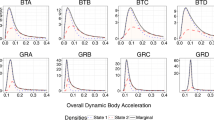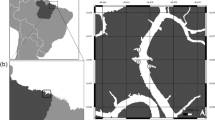Abstract
We examined the diel activity pattern of the sea cucumber Apostichopus japonicus with or without the presence of food and predators. We also tested whether they have the capability for time–place learning. In the feeding experiment, juvenile and adult sea cucumbers were fed at either 00:00 or 12:00, at a fixed feeding place for 12 days, and the presence of animals in the feeding area was recorded. In the predator experiment, juvenile sea cucumbers were kept in a tank with or without a filefish, and the emergence of juvenile sea cucumbers outside the oyster shell area was recorded. Juvenile sea cucumbers did not show a diel activity rhythm, whereas adults were nocturnal, but this was altered by feeding at 12:00. Neither juveniles nor adults appeared in the feeding area before feeding time, suggesting an inability for time–place learning. Juvenile sea cucumbers hid under the oyster shells during the daytime and were active at night in the presence of a filefish, but without a filefish, they also showed high activity in the daytime. We suggest that sea cucumbers change their activity depending on the presence of food and predators, but without the influence of time–place learning.




Similar content being viewed by others
References
Purcell SW, Mercier A, Conand C, Hamel JF, Toral-Granda MV, Lovetelli A, Uthicke S (2013) Sea cucumber fisheries: global analysis of stocks, management measures and drivers of overfishing. Fish Fish 14:34–59
Huiling S, Mengqing L, Jingping Y, Bijuan C (2004) Nutrient requirements and growth of the sea cucumber, Apostichopus japonicus. In: Lovatelli A, Conand C, Purcell S, Uthicke S, Hamel JF, Mercier A (eds) Advances in sea cucumber aquaculture and management. FAO, Rome, pp 327–331
Yamana Y, Hamano T, Goshima S (2009) Laboratory observations of habitat selection in aestivating and active adult sea cucumber Apostichopus japonicus. Fish Sci 75:1097–1102
Yamana Y (2014) A review on the study of sea cucumber in modern Japan. In: Hirota S, Matiguchi Y (eds) The fishery and management of sea cucumbers—resource, production and market. Kouseisya Kouseikaku, Tokyo, pp 297–316 (in Japanese)
Hatanaka H, Uwaoku H, Yasuda T (1996) Experimental studies on the predation of juvenile sea cucumber, Stichopus japonicus by sea star, Asterina pectinifera. Aquac Sci 42:563–566 (in Japanese with English abstract)
Tanaka M (2000) Diminution of sea cucumber Stichopus japonicus juveniles released on artificial reefs. Bull Ishikawa Prefect Fish Res Cent 2:19–29
Dong G, Dong S, Wang F, Tian X (2010) Effects of light intensity on daily activity rhythm of juvenile sea cucumber, Apostichopus japonicus (Selenka). Aquac Res 41:1640–1647
Biebach H, Falk H, Krebs JR (1991) The effect of constant light and phase shifts on a learned time–place association in garden warblers (Sylvia borin): hourglass or circadian clock? J Biol Rhythm 6:353–365
Reebs SG (1996) Time–place learning in golden shiners (Pisces: Cyprinidae). Behav Process 36:253–262
Delicio HC, Barreto RE (2008) Time–place learning in food-restricted Nile tilapia. Behav Process 77:126–130
Schatz B, Beugnon G, Lachaud JP (1994) Time–place learning by an invertebrate, the ant Ectatomma ruidum Roger. Anim Behav 48:236–238
Landenberger DE (1966) Learning in the Pacific starfish Pisaster giganteus. Anim Behav 14:414–418
Cloninger CR, Gilligan SB (1987) Neurogenetic mechanisms of learning: a phylogenetic perspective. J Psychiat Res 21:457–472
Slater MJ, Carton AG, Jeffs AG (2010) Highly localised distribution patterns of juvenile sea cucumber Australostichopus mollis. N Z J Mar Freshw 44:201–216
Urriago JD, Himmelman JH, Gaymer CF (2012) Sea urchin Tetrapygus niger distribution on elevated surfaces represents a strategy for avoiding predatory sea stars. Mar Ecol Prog Ser 444:85–95
Yokoyama H (2013) Growth and food source of the sea cucumber Apostichopus japonicus cultured below fish cages—potential for integrated multi-trophic aquaculture. Aquaculture 372:28–38
Hatanaka H, Tanimura K (1994) Application of menthol as an anesthetizer for body size measuring of sea-cucumber juveniles. Aquac Sci 42:221–225 (in Japanese with English abstract)
R Core Team (2014). R: a language and environment for statistical computing. R Foundation for Statistical Computing, Vienna, Austria (http://www.R-project.org/)
Kato A, Hirata H (1990) Effects of water temperature on the circadian rhythm of the sea-cucumber, Stichopus japonicus in culture. Aquac Sci 38:75–80 (in Japanese with English abstract)
Coulon P, Jangoux M (1993) Feeding rate and sediment reworking by the holothuroid Holothuria tubulosa (Echinodermata) in a Mediterranean seagrass bed off Ischia Island, Italy. Mar Ecol Prog Ser 92:201–204
Mercier A, Battaglene SC, Hamel JF (1999) Daily burrowing cycle and feeding activity of juvenile sea cucumbers Holothuria scabra in response to environmental factors. J Exp Mar Biol Ecol 239:125–156
Slater MJ, Jeffs AG, Swell MA (2011) Organically selective movement and deposit-feeding in juvenile sea cucumber, Australostichopus mollis determined in situ and in the laboratory. J Exp Mar Biol Ecol 409:315–323
Kitano M, Kurata K, Kozuki Y, Murakami H, Yamasaki T, Yoshida H, Sasayama H (2003) Effects of deposit feeder Stichopus japonicus on algal bloom and organic matter contents of bottom sediments of the enclosed sea. Mar Pollut Bull 47:118–125
Uekusa R, Yoshida N, Kashio S, Tokaji H, Asami A, Nakahara K, Goshima S (2012) Low discovery rate of sea cucumber Apostichopus japonicus juveniles after seed release in the field. Bull Fish Sci Hokkaido Univ 62:43–49
Goshima S, Fujiyoshi Y, Ide N, Gamboa RU, Nakao S (1994) Distribution of Japanese common sea cucumber, Stichopus japonicus in Lagoon Saroma. Aquac Sci 42:261–266 (in Japanese with English abstract)
Acknowledgments
We thank Drs. Hideki Sawada, Sanshiro Kaneko (MFRS), Kenji Minami (Hokkaido University), Masahiro Nakamura (Tokyo University), and two anonymous reviewers for providing valuable comments on the manuscript. This study was partly supported by the Coastal Ecosystem Complex Project of the Ocean Resource Use Promotion Technology Development Program, MEXT of Japan.
Author information
Authors and Affiliations
Corresponding author
Rights and permissions
About this article
Cite this article
Yamaguchi, M., Masuda, R. & Yamashita, Y. Diel activity of the sea cucumber Apostichopus japonicus is affected by the time of feeding and the presence of predators but not by time–place learning. Fish Sci 82, 29–34 (2016). https://doi.org/10.1007/s12562-015-0944-x
Received:
Accepted:
Published:
Issue Date:
DOI: https://doi.org/10.1007/s12562-015-0944-x




